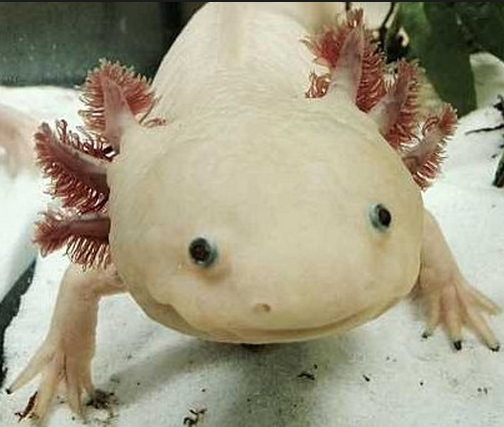
flickr.com
While the turitopsis nutricula jellyfish has been in the red-hot spotlight for some time due to its, um, biological mortality—hello forever young!—the axolotl has yet to receive the same kind of adoration—though theoretically it could offer humanity a similarly appealing fix for our deeply flawed bodies. Namely, that once a limb is lopped off, it ain't coming back.
(What would happen to the entire grind-house genre and Quentin Tarantino's gore-glutted empire if all those arms and legs could miraculously be regrown is another story entirely. Being dismembered by a samurai sword just isn't that scary if you can grow one back in a few weeks, amiright?)
Anyway.
The axolotl "water monster" (also known as a "Mexican walking fish") is not a fish at all as it happens—it's an amphibious salamander. A neotenic salamander to be exact, which, without getting into a morass of genetics, basically means that they've retained juvenile physical characteristics in their adulthood, never shedding their aquatic form—like their gills—despite their maturation. Rather than developing lungs and getting their asses over to the land that's high and dry, they remain water-dwelling, never undergoing metamorphosis.
The delightfully odd looking axolotl are sadly critically endangered and may have disappeared forever, at least in the wild. A recent four-month survey of Mexico City's Xochimilco lakes and canals (the axolotls' only natural habitat) resulted in empty nets and heavy hearts; they found no trace of any axolotl, whose numbers have been dropping steadily in the past decade due to chronic pollution and industrialization.
In addition to being generally adorable-ugly—boasting four stumpy legs, feather-like gills and a twisted little grin—the axolotl is capable of regenerating its lost limbs and in some documented cases, even their eyes and parts of their brain. Oh, and they can also readily accept transplants from other axolotl brethren, rendering the alien body parts completely functional. Sometimes they'll even repair the damaged limb and then grow another one for the hell of it, much to the delight of novelty pet owners everywhere.
Not surprisingly, doctors are more-than-keen to see if we can emulate the axolotl's regenerative powers; in 2009, the U.S. Department of Defense offered a $6.5 million grant to Tulane University cell and molecular biology professor Ken Muneoka to study the slippery brute and crack its biological code.
While the initial healing process between humans and salamanders is strikingly similar—fibroblasts start creating new tissue—the salamanders' bodies cease once "normal architecture has been restored," while human bodies create loads of pesky scar tissue. The doctors discovered that when injured, the axolotls' mature bodies develop limbs as though it was the very fist time, with no scar tissue to speak of. These "stemlike cells" are called a blastema.
The key to human regeneration is preventing the formation of scar tissue and instead, forcing the body to create a blastema; Muneoka claims we are only a "decade or two" away from achieving this mega-leap in medicine.


